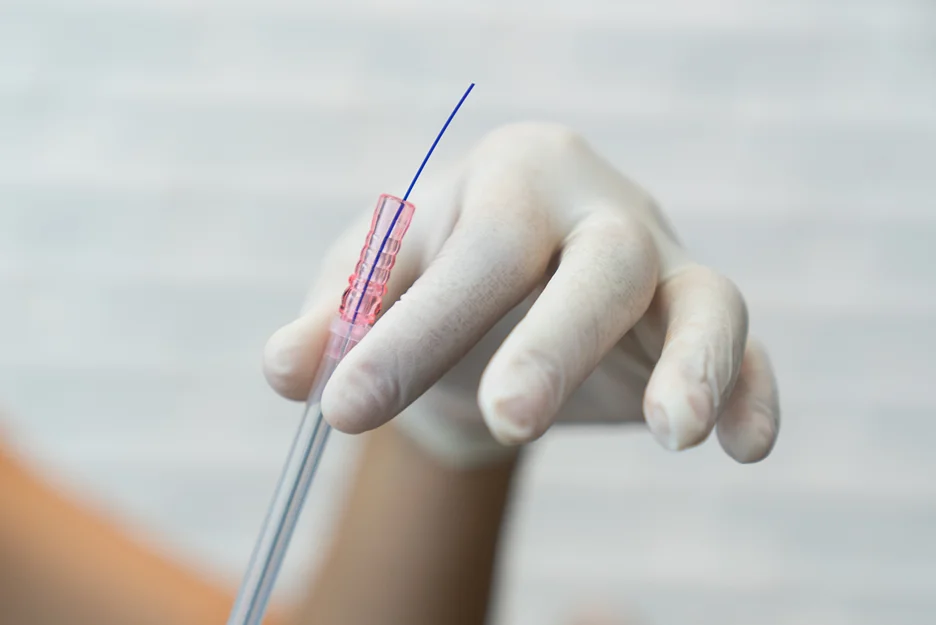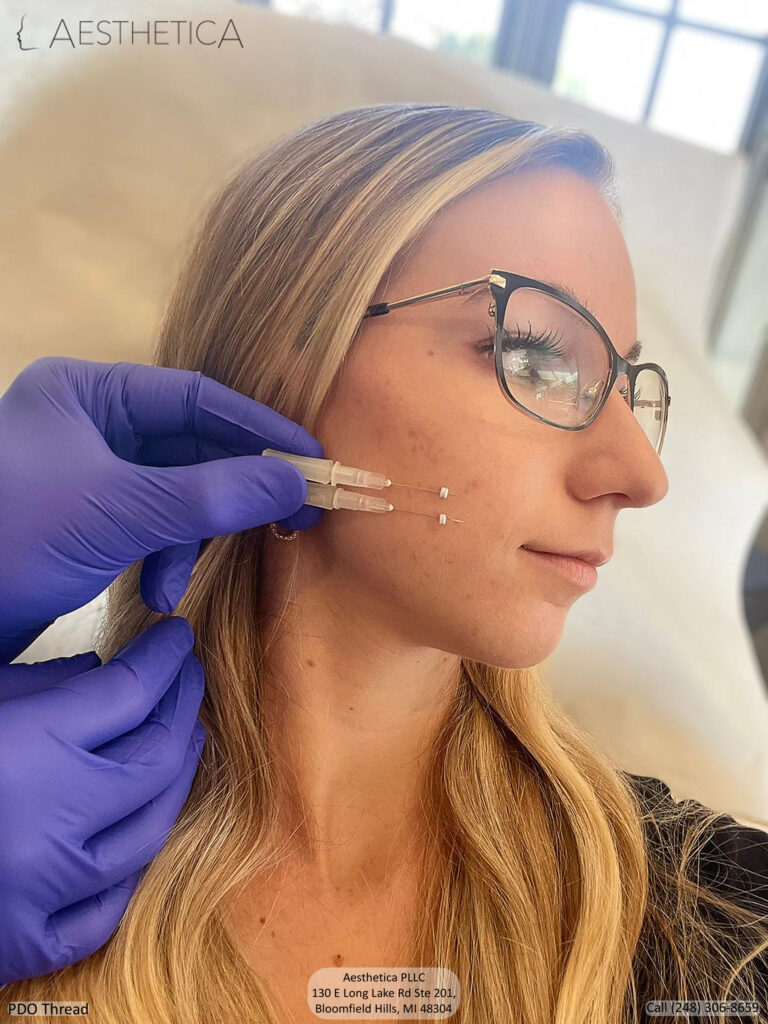
PDO threads are an increasingly popular option for face lifting for their minimally invasive technique, minimal downtime, and use of dissolvable sutures for minimal downsides. The PDO threads come in various shapes, sizes, and structures to provide different forms of facial rejuvenation.
So what are the threads and gauges available for PDO thread lifting? The main types of PDO threads are mono, screw, cogs, and embossed thread that promote different degrees of lifting, tissue growth, skin tightening, and slimming—each are with their own needle gauge. Consult a dermatologist to choose which thread/s would be best for your current condition and expectations.
Aesthetica can assist you with all your beauty needs, helping you achieve your maximum beauty and aesthetic potential. Call or contact us today to learn more about our cosmetic services.
PDO threads are made of polydioxanone (PDO) sutures that induce collagen production after it has been added in the skin, leaving no visible scar after the treatment has been resolved. The types of threads differ in their required needle gauge, diameter, length, and inclusion of barbs to hold on to the skin. These are the following PDO threads types:
These threads are the base form of PDO Threads as they are smooth threads that are 6/0 to 8/0 in diameter. They are inserted through a 26 to 30G needle to position deep in the skin. An anchor point must be added to the thread so it can latch on the scalp or be embedded in the face for consistent lifting. The collagen will start forming around the inserted threads to help tighten the skin and add some volume to the affected area.
A screw thread is an intertwined PDO thread—5/0 to 8/0 in diameter—wrapped around a 26 to 30 G needle that is stitched in the sub-dermis or the deep dermis. They can provide a greater amount of volume in sunken areas in the skin due to excessive dimpling or sagging. Another thread may be added for a more potent effect. Hence, these threads are used for general facelifting in any treatable areas around the head.
Cog threads are mono threads that are similar in diameter and needle gauge. They have barbs attached around them to hook on the undersurface of the skin, so they don’t require any anchoring points. This will tighten the sagging skin as the collagen produces around the thread: creating a stronger and fuller lift. This type of thread is best suited for areas around the jawline to lessen jowls.
This new type of thread is mono threads that have microgrooves where the skin, produced by the newly created collagen, will grow into the treated area. This will promote collagen production while suspending the tissue in place, similar to cog threads.
A PDO thread lift is applied by attaching an anchor point, if there are no barbs present, to better position the suture for lifting. Once the absorbable threads are inserted into the skin and fully dissolved, they induce college stimulation to promote long-term face lifting. The type of thread affects the level of lifting and skin volume that will result once the skins have incorporated the sutures.
A combination of threads can be utilized to fix different areas of the face in a single procedure that needs lifting support. For example, mono threads can be used across the cheeks to increase the collage in that area to remove wrinkles while cog threads will be applied on the chin to lessen a nasolabial fold.
Ensure that your medical provider is knowledgeable on the exact skin tissue each PDO thread type is required to be stitched in. However, all PDO threads accomplish the same goal: to naturally create more collagen in sagging and wrinkled areas of the skin to lift them.
As with any facelift procedure and plastic surgery, there are established and known side effects of PDO thread lifting. These are expected in all forms of PDO Threads within the first 2 days after the procedure and can last up to 1 to 2 weeks.
If your skin is thin, there may be visible lines across the face where the threads were stitched in. This side effect may also be accompanied by puckering or dimpling as the skin is still adjusting to the presence of the threads. However, this may be caused by improper positioning of the suture as they should be embedded deep within the skin. PDO threads are dissolvable so the visibility of the sutures should disappear after a few days.
There may be minor pain or discomfort in the treated area within 2 days after the procedure. The threads are designed to latch in between the tissues of the skin, if not stitched properly or placed deep in the affected area the chances of pain will increase. Any form of pain should subside after 5 days and will disappear completely after two weeks. If a painkiller is required, use Tylenol instead of aspirin as it makes the face prone to bruising.
Swelling and puckering in the face are also known side effects of the procedure. It may be worrisome to see the skin react negatively to the threads, but giving it ample time and space to rest, especially if the treatment was recent, will help immensely. Apply ice in the affected area, rest at a reclined position, and maintain a neutral facial expression to help settle the skin with the PDO threads.
The blood vessels in the skin may be punctured in the procedure, making the facial skin prone to bruising. Anything that could thin the blood vessels and suddenly increase blood pressure will raise the likelihood of it occurring.
Avoid intense exercise, food-thinning substances and foods, alcohol, and smoking for a week before and two weeks after the procedure, especially if the patient is prone to bruising. Cold compress, arnica oil, and hydration can help reduce the effect and profile of the bruise.
PDO threads of any type can take up to 6 months to completely dissolve in the treated area. After the side effects from the procedure have cleared up, there will be immediate results in the form of increased volume in the treated area, face lifting, and skin tightening.
These are in regions where wrinkles were present as the PDO threads have increased collagen production in the face. Improvements from the thread lift will stop after 6 months and may generally last a year or 12 months.
The overall longevity of the thread lifting depends on the condition of the skin and the age of the patient. Older patients or those with higher degrees of skin laxity will have positive effects from the treatment for up to a year. Younger patients or those with excellent skin conditions can extend the results to a few months after the first year.
Activities that sag your skin will decrease the effects of PDO Threads. These include, but aren’t limited to, constant exaggerated face movements, hot showers, alcohol consumption, smoking, and overexposure to sunlight through sunbathing or staying outdoors without a shade as the UV rays can damage the collagen in the face.

There are effective methods to maintain and increase the effects of PDO Threads and the skin's health and condition, leading to better resistance against sagging and wrinkling.
Nourishing the body with nutrients, antioxidants, and frequent hydration will benefit the skin in the treated area. Vitamin A found in green vegetables, fruits, and egg yolks helps sustain the skin to prevent wrinkles and promote smoother skin.
Vitamin C in citrus fruits and other fruits increases collagen production to help build skin volume in the body. Consuming multivitamin supplements and a varied diet of fruits and vegetables can foster fantastic long-term effects on the body and the skin.
Meanwhile, water moisturizes and regulates the elasticity of the skin—safeguarding it against sagging, wrinkles, fine lines, scars, and pimples. The daily recommended intake for adults is 6 to 8 glasses of water. Retaining this level can plump up the skin for protection against skin laxity.
Alcohol consumption and smoking are prohibited before and after the procedure as it has confirmed negative effects on the skin and its tissues. When alcohol enters the bloodstream through digestion, it dehydrates the body as it takes water and nutrients from the organs. This process dries the skin, making it prone to wrinkling, bruising, and sagging.
On the other hand, smoking will introduce nicotine to the body which thins the blood vessels, reducing the rate oxygen and vitamins are absorbed by the skin. The act of sucking in smoke and the presence of heat in any lingering smoke will also promote wrinkling and sagging in the face. Taking a break from these substances will see improvements to your skin and your overall well-being.
Adding moisturizers and anti-aging products to the face will help the skin stay youthful and fresh. With the right product, moisturizing can lessen any blemishes in the face, reduce wrinkles and sagging, and provide a gentle protective sheen in the face.
Check what chemicals are present in the products you’re using to ensure there are no adverse side effects or conditions that accompany its use. However, be careful of excessively touching your face as it may sag your skin.
What PDO thread to utilize will ultimately depend on the level of sagging or wrinkling in the target areas, how many threads are required in the facelift, the desired extent of facial rejuvenation, and price points. Mono threads will provide the necessary amount of collagen in any part of the face, but may not sustain the lifting in saggier areas of the face as well as barbed threads such as a cog thread.
The choice of PDO thread must also be accompanied by expert guidance, proper procedure, and high-quality threads. Confirm that your medical provider is using PDO threads from a reputable source. Also, take note of the pain each thread type might cause as it may be uncomfortable to receive during the procedure. Anesthesia will be added across the face so the patient may only feel pushing and tugging sensations throughout the procedure.

PDO thread lifts are a great option to instantly plump up the face. However, choosing which one to utilize may be a difficult task. Most of all, you need a reliable and experienced medical spa that can help you maximize all the benefits and minimize the risk of undesirable side effects of the PDO thread lift.
At Aesthetica, our specialists know the ins and outs of the procedure and the various PDO threads that can be applied. We can provide expert aftercare and natural skin care products to lengthen the duration and efficacy of the PDO threads. Schedule a consultation with one of our expert dermatologists today.
Aesthetica can assist you with all your beauty needs, helping you achieve your maximum beauty and aesthetic potential. Call or contact us today to learn more about our cosmetic services.